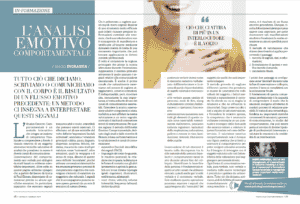
Conscious Motivation
14 October 2019
MANAGEMENT AND MANAGEMENT OF EMOTIONS
6 November 2019EMOTIONAL-BEHAVIOURAL ANALYSIS

Column “PSYCHOLOGY OF EMOTIONS” by Diego Ingrassia – “EMOTIONAL-COMPORTANT ANALYSIS AND NEW TECHNOLOGIES”
for PSICOLOGIA CONTEMPORANEA – Transgression – no. 271, January-February 2019 – GIUNTI EDITORE
EVERYTHING WE SAY, WRITE OR COMMUNICATE WITH THE BODY IS THE RESULT OF A PREVIOUS EMOTIONAL FLOW: A METHOD TEACHING US TO INTERPRET THESE SIGNALS
Emotional Behavioural Analysis is an interactive method that integrates a set of skills aimed at gaining an in-depth understanding of a subject’s emotional experience through evaluative analysis techniques that examine 6 different communication channels.
The observation of non-verbal behaviour can draw on studies based on important scientific evidence.
On other occasions on these pages, we have explained that, starting with the research work of Paul Ekman, we have precise knowledge about certain specific emotions. In particular, we know that there are unequivocal and very reliable signals that can be observed.
We refer to certain facial expressions defined as ‘universal facial expressions’, associated with seven main emotions: anger, fear, disgust, contempt, surprise, happiness, sadness, but studies are under way to assess other emotions, such as shame and guilt, as ‘universal’.
Some of these are defined as ‘secondary’ because they activate systematic connections between primary emotions and cognitive comprehension processes involving both subjective and cultural elements.
The accompanying signals can often be generated by a mix of emotions of a different nature.
Those who are trained to pick up on these rapid micro-signals have a very effective tool at their disposal: they can extract valuable emotion-related information that their interlocutor is not aware of manifesting and verify it instantly by means of targeted questions.
This is an important tool that can be applied in different professional contexts.
The face is certainly the main region that attracts our attention during interaction; it represents the primary system through which emotional communication signals pass.
It is also the first channel we naturally observe when trying to capture attitudes, moods and intentions.
It is essential, however, to remember that despite its importance, it is only one of the observable channels of communication.
Extending our observation to other components helps us, among other things, not to entrust our evaluation to a single signal, running the risk of committing errors of interpretation.
This is why the method of Emotional Behavioural Analysis, derived from Ekman’s studies and research, is based on the observation and evaluation of 6 communication channels
– facial expressions: decoding of signals (FACS);
– body language: gaze, postural reactions; relationship with space, distance and forms of contact with others (proxemics and haptics); gestures with their different typologies (gestures: regulating, illustrative, emblematic, adaptive)
– voice: rhythm; speed; volume (intensity); frequency (pitch); timbre (quality); verbal content: understood as the narrative account verbalised by the interlocutor and the search for key words revealing aspects of values and motivation;
– verbal style: pauses; change of pronouns; culturally related idioms, slang; stuttering or repetition; evasive sentences;
– autonomic nervous system: not all elements of this channel are normally observable from the outside, we can however record: changes in respiration; sweating; paleness or redness in the face; lacrimation; tremors; dilation of the pupils.
The observation of these elements is based on the discrepancy between the person’s natural style (baseline) and the behaviours enacted during certain phases of the interview.
Identifying the person’s baseline is crucial with respect to all the channels we have listed, thus also for verbal style and verbal content. Only by doing this can we separate the signals that belong to the subject’s ‘normality’ from those that will be important to investigate.
The method involves sifting through different hypotheses that take into consideration: the individual characteristics of the subject, environmental factors and of course the context (the background against which the relationship is set and which influences its dynamics).
After having collected the data as a result of this observation, and formulated the relevant hypotheses, the skill that needs to be used contemplates a punctual and strategic use of questions that will be aimed at assessing the hypotheses formulated during the interview.
The emotional-behavioural evaluator is thus not an aseptic figure who merely observes behaviour: in order to be able to carry out an accurate analysis, he/she needs to interact with the evaluated subject; only in this way can the reliability of the evaluation reach high percentages.
Every form of communication – verbal, para-verbal, non-verbal or mediated by new technologies – is preceded and guided by emotion.
Everything we say, write, beyond the fact of being immediately comprehensible or not, is the result of a previous emotional flow.
Therefore, it is of paramount importance to know what to observe in order to recognise these emotional manifestations and focus our attention on a few specific key points.
The assessment method we are describing is applied by following three steps:
1. collection of signals, data and information;
2. formulation of hypotheses and verification through questions;
3. final evaluation.
The first two steps are “circular” throughout the observation and interview phase, while the third will be completed with the final evaluation. The foundation of this professional competence is the ability to understand the role emotions play within a variety of possible relationship processes. It is a methodology, based on important research concerning emotions, communication processes, and the study of behaviour, that can be placed at the service of different types of professionals interested in assessing the emotions and credibility of an interlocutor.



